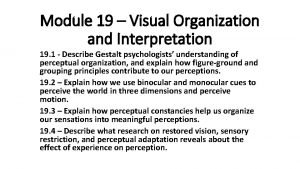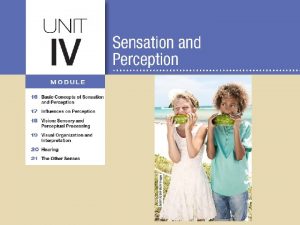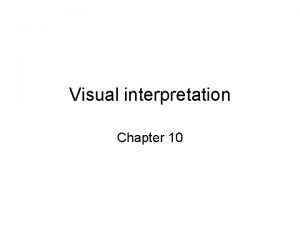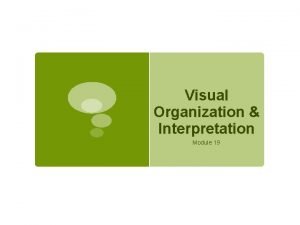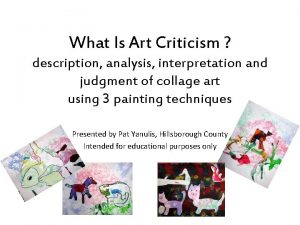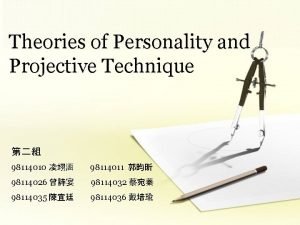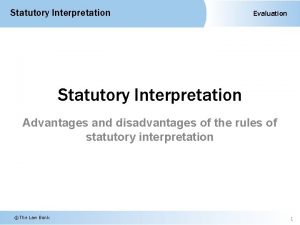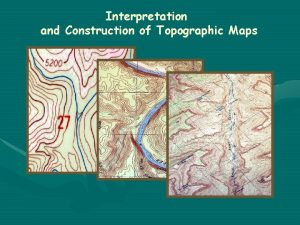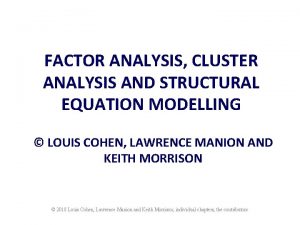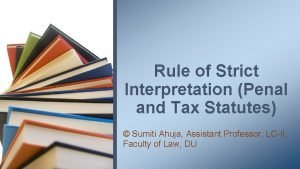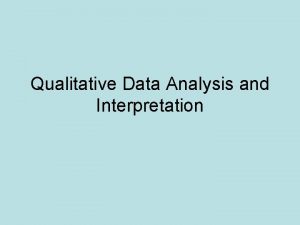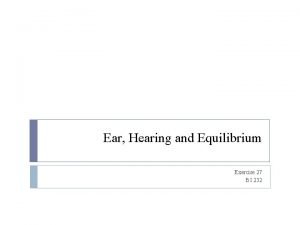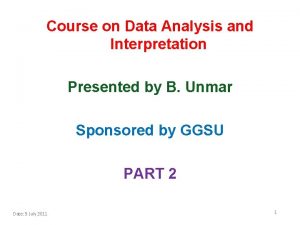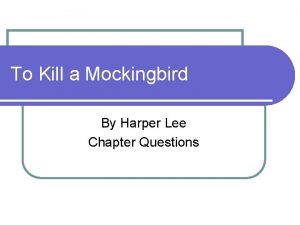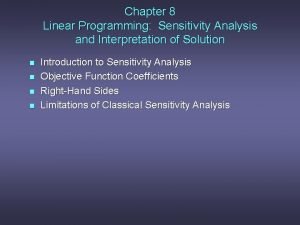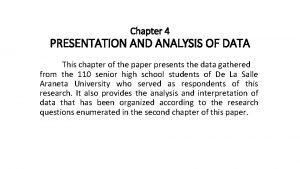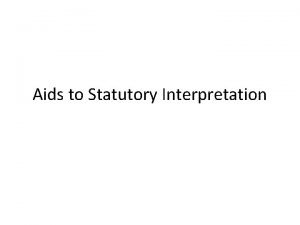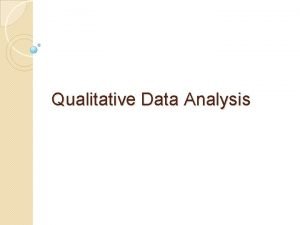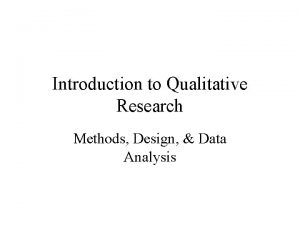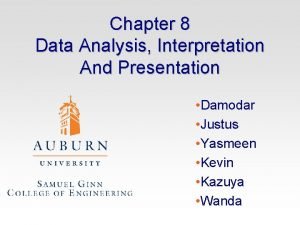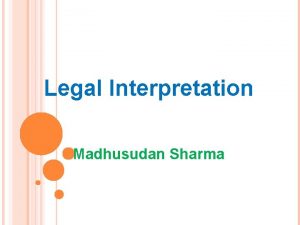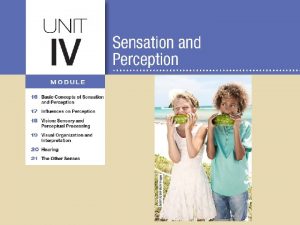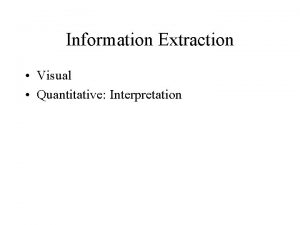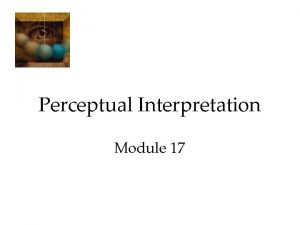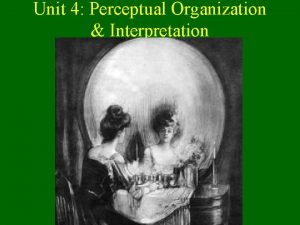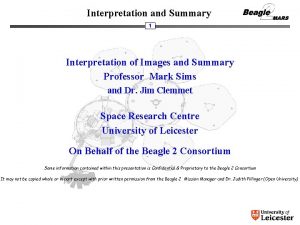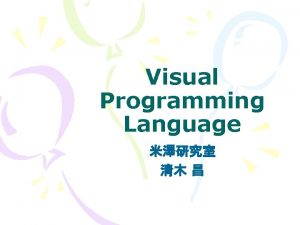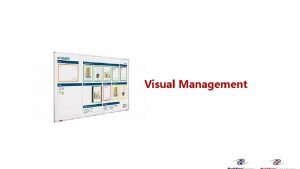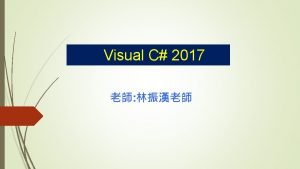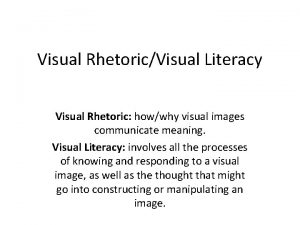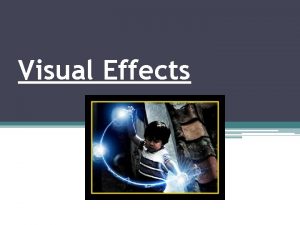Module 19 Visual Organization and Interpretation 19 1































- Slides: 31

Module 19 – Visual Organization and Interpretation 19. 1 - Describe Gestalt psychologists’ understanding of perceptual organization, and explain how figure-ground and grouping principles contribute to our perceptions. 19. 2 – Explain how we use binocular and monocular cues to perceive the world in three dimensions and perceive motion. 19. 3 – Explain how perceptual constancies help us organize our sensations into meaningful perceptions. 19. 4 – Describe what research on restored vision, sensory restriction, and perceptual adaptation reveals about the effect of experience on perception.

19. 1 - Describe Gestalt psychologists’ understanding of perceptual organization, and explain how figure-ground and grouping principles contribute to our perceptions. • How do we form meaningful perceptions from sensory information? A group of German psychologists noticed that when given a cluster of sensations people tend to organize them into gestalt, or an organized meaningful whole.

FIGURE-GROUND PERCEPTION • Figure-Ground Perception: the ability to distinguish between the figure as the foreground and the ground as the background.

GROUPING PRINCIPLES • After distinguishing the ground, our perception needs to organize the figure into a meaningful form using grouping rules. • Grouping Principles: • 1) Proximity – the tendency to perceive objects that are close together as belonging together. • 2) Similarity – the tendency to group similar objects together to make one whole. • 3) Continuity – the tendency to see an object as continuing despite an obvious break. • 4) Closure – the tendency to fill in the missing spaces to complete the object and see it as a whole. • 5) Common Fate – The tendency to see objects that move in the same direction as together.

Proximity – the tendency to perceive objects that are close together as belonging together.

Similarity – the tendency to group similar objects together to make one whole.

Continuity – the tendency to see an object as continuing despite an obvious break.

Closure – the tendency to fill in the missing spaces to complete the object and see it as a whole.

Common Fate – The tendency to see objects that move in the same direction as together.

19. 2 – Explain how we use binocular and monocular cues to perceive the world in three dimensions and perceive motion. • Depth Perception: the ability to see objects in three dimensions although the images that strike the retina are two dimensional – it enables us to judge distances. • Visual Cliff: a laboratory device for testing depth perception in infants and young animals. Gibson and Walk suggested that human infants (crawling age) have depth perception using the visual cliff demonstration.

Binocular Cues: depth cues, such as retinal disparity, that depend on the use of two eyes. • 1) Retinal Disparity: a binocular cue for perceiving depth. By comparing images from the retinas in the two eyes, the brain computes distances – the greater the disparity (difference) between the two images, the closer the object. • 2) Convergence: turning inward of each eye to focus on an up-close object. As objects move closer to our noses, our eyes converge and take on a “cross-eyed” appearance. This is due to the fact that our eyes are close together so they must turn inward in order to create a clear image for each retina.

Monocular Cues: information perceived from one eye that plays a crucial role in the ability to detect depth perception. • 1) Relative Size or Area: the size/area of an object is judged to be relative to the size/area of objects that surround the original object. The closer an object, the larger it appears to be. • 2) Interposition: the object that is farther away is partially hidden by the object that is closer. • 3) Texture Gradient: lesser clarity is perceived as being farther away. • 4) Motion Parallax: objects that are farther away appear to move in the same direction at the same rate; closer objects move at a rapid speed in the opposite direction. • 5) Relative Height: we perceive objects that are higher in our field of vision to be farther away that those that are lower. • 6) Linear Perspective: parallel lines, such as railroad tracks, appear to converge in the distance. • 7) Light and Shadow: nearby objects reflect more light into our eyes than more distant objects. Given two identical objects, the dimmer one appears to be farther away.

Relative Size or Area: the size/area of an object is judged to be relative to the size/area of objects that surround the original object. The closer an object, the larger it appears to be.

Interposition: the object that is farther away is partially hidden by the object that is closer.

Texture Gradient: lesser clarity is perceived as being farther away.

Motion Parallax: objects that are farther away appear to move in the same direction at the same rate; closer objects move at a rapid speed in the opposite direction.

Relative Height: we perceive objects that are higher in our field of vision to be farther away that those that are lower.

Linear Perspective: parallel lines, such as railroad tracks, appear to converge in the distance.

Light and Shadow: nearby objects reflect more light into our eyes than more distant objects. Given two identical objects, the dimmer one appears to be farther away.

Perception of Movement – the human brain is able to correct for the time delay that is experienced as information travels from the retina to the optic nerve and finally to the visual cortex. To correct this delay the brain simply fills in the missing pieces, based largely on experience. • 1) Autokinetic Effect • 2) Stroboscopic Motion • 3) Phi Phenomenon

Autokinetic Effect • 1) Autokinetic Effect: the perception of movement of a stationary point of light in a totally darkened room. If you are in a room that is completely darkened except for a single point of light, and you fixate your gaze on that point of light, it will appear to move. The reason for this apparent movement is because the stationary point of light is being projected on a featureless background, and your eyes have no point of reference against which to judge it.

Stroboscopic Motion • 2) Stroboscopic Motion: the perception of movement due to the rapid presentation of changing stationary images. Movies are the rapid presentation of stationary images. The fact that the movie appears to move smoothly is due to this rapid succession of stationary images.

Phi Phenomenon • 3) Phi Phenomenon: apparent movement due to the sequential presentation of stationary images. If an image of a circle is presented on the left side of a screen for a brief moment, and then a circle is presented on the right side of the screen, many people would say the image had moved from left to right. However, there was no movement, only the appearance of movement created by the presentation and then quick removal of the circle on the left, followed by the presentation and quick removal of the circle on the right.

19. 3 – Explain how perceptual constancies help us organize our sensations into meaningful perceptions. • Perceptual Constancy: perceiving objects as unchanging (having constant shapes, size, lightness, and color) even as illumination and retinal images change. • 1) Shape Constancy: the perception that the shape of an object remains the same despite a change in the angle from which it is viewed. • 2) Color Constancy: the perception that the color of an object remains the same despite a change in the lighting. • 3) Brightness Constancy: the perception that the brightness of an object remains the same despite a change in the brightness of the background. • 4) Size Constancy: the perception that the size of an object remains the same despite the fact that size changes based on distance.

1) Shape Constancy: the perception that the shape of an object remains the same despite a change in the angle from which it is viewed.

2) Color Constancy: the perception that the color of an object remains the same despite a change in the lighting.

3) Brightness Constancy: the perception that the brightness of an object remains the same despite a change in the brightness of the background.

4) Size Constancy: the perception that the size of an object remains the same despite the fact that size changes based on distance.

Ames Room Illusion

Ames Room Illusion

19. 4 – Describe what research on restored vision, sensory restriction, and perceptual adaptation reveals about the effect of experience on perception. • Perceptual adaptation: the visual ability to adjust to an artificially displaced or inverted visual field. Experiments involving inversion glasses reveal that after about a week people can adapt to the change, and even ride a motorcycle, ski, and fly an airplane.
 Module 19 visual organization and interpretation
Module 19 visual organization and interpretation Narmeen is viewing the board in the classroom
Narmeen is viewing the board in the classroom How does interpretation b differ from interpretation a
How does interpretation b differ from interpretation a Elements of photo interpretation
Elements of photo interpretation Point to point organization
Point to point organization C device module module 1
C device module module 1 Process organization in computer organization
Process organization in computer organization Gestalt psychology illusions
Gestalt psychology illusions Pengertian pemrograman visual
Pengertian pemrograman visual Module 5 supply and demand introduction and demand
Module 5 supply and demand introduction and demand Description analysis interpretation judgement
Description analysis interpretation judgement Risb test slideshare
Risb test slideshare Computer architecture: concepts and evolution
Computer architecture: concepts and evolution Golden rule advantages and disadvantages
Golden rule advantages and disadvantages Topographic map construction
Topographic map construction Difference between factor analysis and cluster analysis
Difference between factor analysis and cluster analysis Strict interpretation
Strict interpretation Example of analysis and interpretation of data
Example of analysis and interpretation of data Interpretation and construction
Interpretation and construction Rinne test
Rinne test Analyze vs interpret
Analyze vs interpret Explain jem's and scout's interpretation of the dewey
Explain jem's and scout's interpretation of the dewey Importance of context in discourse analysis
Importance of context in discourse analysis Sensitivity analysis and interpretation of solution
Sensitivity analysis and interpretation of solution Data presentation and analysis
Data presentation and analysis Extrinsic and intrinsic aids to statutory interpretation
Extrinsic and intrinsic aids to statutory interpretation Difference between observation and interpretation
Difference between observation and interpretation Translation and interpretation network
Translation and interpretation network Deductive coding
Deductive coding Interpretation of data
Interpretation of data Introduction of data analysis and interpretation
Introduction of data analysis and interpretation Data analysis, interpretation and presentation
Data analysis, interpretation and presentation
